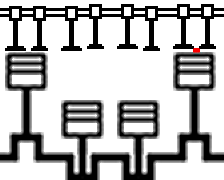|
|
In-line Four-cylinder Engine

Function
While for cars the four cylinder in-line engine competes rather with the three-cylinder in-line engine, for two-wheeled vehicles, in general, the four cylinder in-line competes with the two-cylinder V engine of the same
cubic capacity. Here the following basic advantages arise which can be given away in some cases of course by the manufacturers:
- higher rotary possibilities and power output due to smaller single cubic
capacities,
- lower engine weight because of compact construction,
- large flow cross sections,
- well-balanced engine run due to more and better distributed ignitions.


How it works
The four cylinder in-line engine has the smallest cylinder number that avoids empty strokes completely if the engine features four strokes because always one cylinder is going through a power stroke. Thus this engine
design combines a relatively low construction expenditure with a good power stroke distribution and a favourable mass balance and occurs still most often.
The two outer pistons move in opposite direction to both internal pistons. The cylinder opposite the force delivery side is mostly named the 1st cylinder. The firing orders are 1342 (figure on top) and 1243, where always
the 1st and 4th are fixed. The crankshaft features with very old engines 2, with older 3 and with all new 5 main bearings.The vertical movements of the engine are compensated. However, the different connecting rod
deflections each generate rotary oscillations which can be reduced, e.g., by equalizer shafts. 05/08
|
|